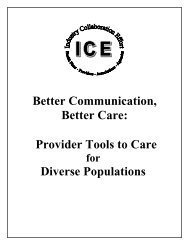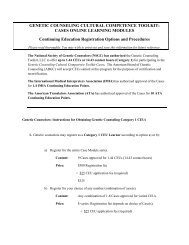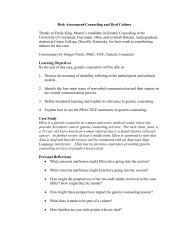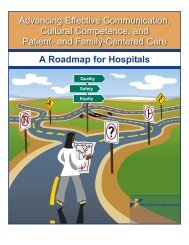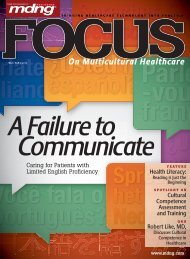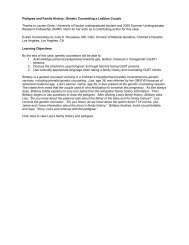making the business case for culturally and linguistically appropriate ...
making the business case for culturally and linguistically appropriate ...
making the business case for culturally and linguistically appropriate ...
You also want an ePaper? Increase the reach of your titles
YUMPU automatically turns print PDFs into web optimized ePapers that Google loves.
NATIONAL STANDARDS FORCULTURALLY AND LINGUSTICALLY APPROPRIATESERVICES (CLAS) IN HEALTH CARECulturally Competent Care (St<strong>and</strong>ards 1-3)St<strong>and</strong>ard 1. Health care organizations should ensure that patients/consumers receive from all staff members’ effective,underst<strong>and</strong>able, <strong>and</strong> respectful care that is provided in a manner compatible with <strong>the</strong>ir cultural health beliefs <strong>and</strong>practices <strong>and</strong> preferred language.St<strong>and</strong>ard 2. Health care organizations should implement strategies to recruit, retain, <strong>and</strong> promote at all levels of <strong>the</strong>organization a diverse staff <strong>and</strong> leadership that are representative of <strong>the</strong> demographic characteristics of <strong>the</strong> service area.St<strong>and</strong>ard 3. Health care organizations should ensure that staff at all levels <strong>and</strong> across all disciplines receive ongoingeducation <strong>and</strong> training in <strong>culturally</strong> <strong>and</strong> <strong>linguistically</strong> <strong>appropriate</strong> service delivery.Language Access Services (St<strong>and</strong>ards 4-7)St<strong>and</strong>ard 4. Health care organizations must offer <strong>and</strong> provide language assistance services, including bilingual staff <strong>and</strong>interpreter services, at no cost to each patient/consumer with limited English proficiency at all points of contact, in atimely manner during all hours of operation.St<strong>and</strong>ard 5. Health care organizations must provide to patients/consumers in <strong>the</strong>ir preferred language both verbal offers<strong>and</strong> written notices in<strong>for</strong>ming <strong>the</strong>m of <strong>the</strong>ir right to receive language assistance services.St<strong>and</strong>ard 6. Health care organizations must assure <strong>the</strong> competence of language assistance provided to limited Englishproficient patients/consumers by interpreters <strong>and</strong> bilingual staff. Family <strong>and</strong> friends should not be used to provideinterpretation services (except on request by <strong>the</strong> patient/consumer).St<strong>and</strong>ard 7. Health care organizations must make available easily understood patient-related materials <strong>and</strong> post signagein <strong>the</strong> languages of <strong>the</strong> commonly encountered groups <strong>and</strong>/or groups represented in <strong>the</strong> service area.Organizational Supports <strong>for</strong> Cultural Competence (St<strong>and</strong>ards 8-14)St<strong>and</strong>ard 8. Health care organizations should develop, implement, <strong>and</strong> promote a written strategic plan that outlinesclear goals, policies, operational plans, <strong>and</strong> management accountability/oversight mechanisms to provide <strong>culturally</strong> <strong>and</strong><strong>linguistically</strong> <strong>appropriate</strong> services.St<strong>and</strong>ard 9. Health care organizations should conduct initial <strong>and</strong> ongoing organizational self-assessments of CLASrelatedactivities <strong>and</strong> are encouraged to integrate cultural <strong>and</strong> linguistic competence-related measures into <strong>the</strong>ir internalaudits, per<strong>for</strong>mance improvement programs, patient satisfaction assessments, <strong>and</strong> outcomes-based evaluations.St<strong>and</strong>ard 10. Health care organizations should ensure that data on <strong>the</strong> individual patient’s/consumer’s race, ethnicity,<strong>and</strong> spoken <strong>and</strong> written language are collected in health records, integrated into <strong>the</strong> organization’s managementin<strong>for</strong>mation systems, <strong>and</strong> periodically updated.St<strong>and</strong>ard 11. Health care organizations should maintain a current demographic, cultural, <strong>and</strong> epidemiological profile of<strong>the</strong> community as well as a needs assessment to accurately plan <strong>for</strong> <strong>and</strong> implement services that respond to <strong>the</strong> cultural<strong>and</strong> linguistic characteristics of <strong>the</strong> service area.St<strong>and</strong>ard 12. Health care organizations should develop participatory, collaborative partnerships with communities <strong>and</strong>utilize a variety of <strong>for</strong>mal <strong>and</strong> in<strong>for</strong>mal mechanisms to facilitate community <strong>and</strong> patient/consumer involvement indesigning <strong>and</strong> implementing CLAS-related activities.St<strong>and</strong>ard 13. Health care organizations should ensure that conflict <strong>and</strong> grievance resolution processes are <strong>culturally</strong> <strong>and</strong><strong>linguistically</strong> sensitive <strong>and</strong> capable of identifying, preventing, <strong>and</strong> resolving cross-cultural conflicts or complaints bypatients/consumers.St<strong>and</strong>ard 14. Health care organizations are encouraged to regularly make available to <strong>the</strong> public in<strong>for</strong>mation about <strong>the</strong>irprogress <strong>and</strong> successful innovations in implementing <strong>the</strong> CLAS st<strong>and</strong>ards <strong>and</strong> to provide public notice in <strong>the</strong>ircommunities about <strong>the</strong> availability of this in<strong>for</strong>mation.12



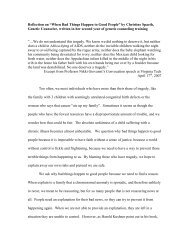
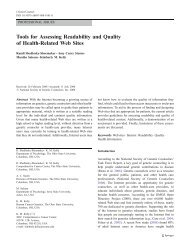

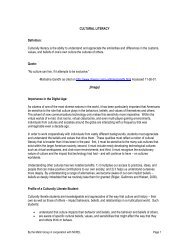
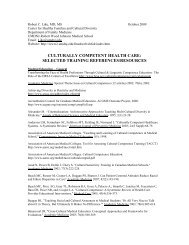

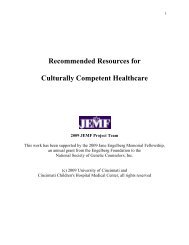
![Breaking Bad News PPT[1] - Genetic Counseling Cultural ...](https://img.yumpu.com/35003134/1/190x146/breaking-bad-news-ppt1-genetic-counseling-cultural-.jpg?quality=85)
